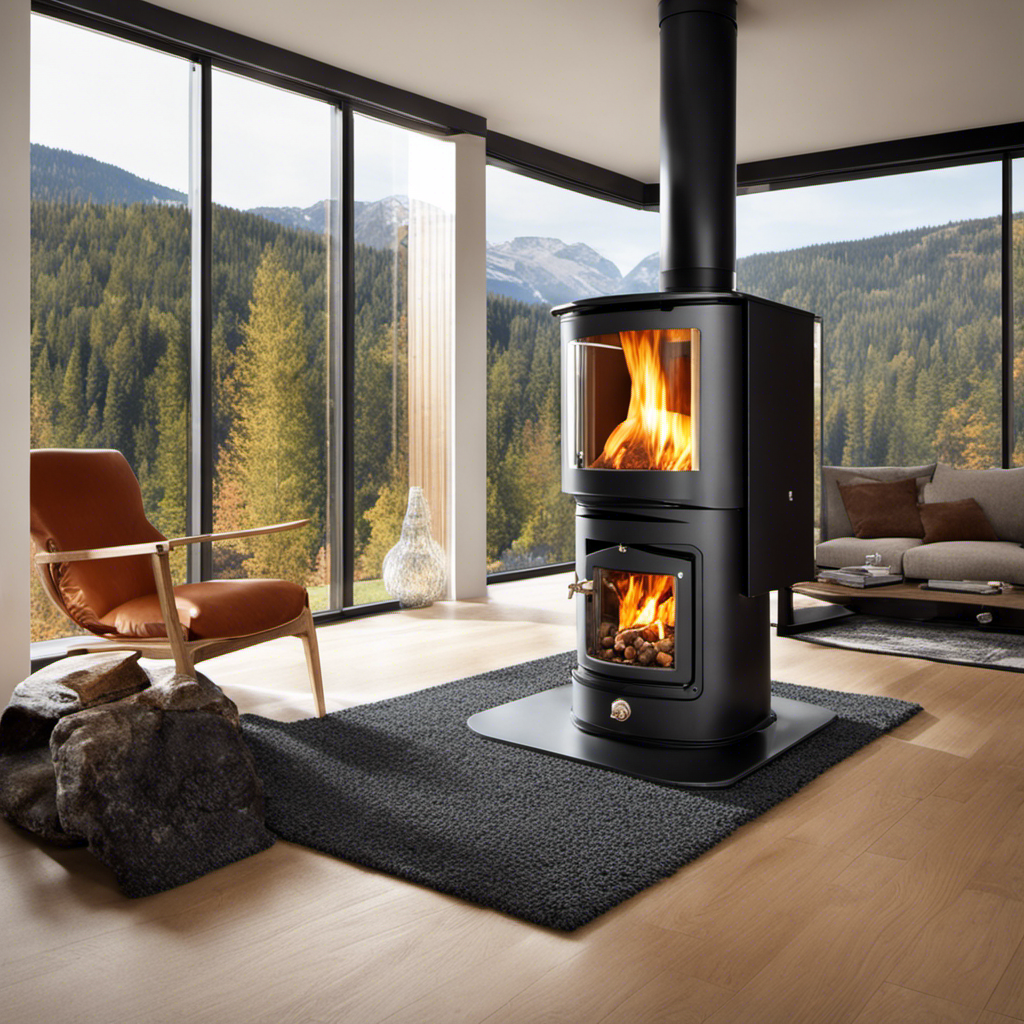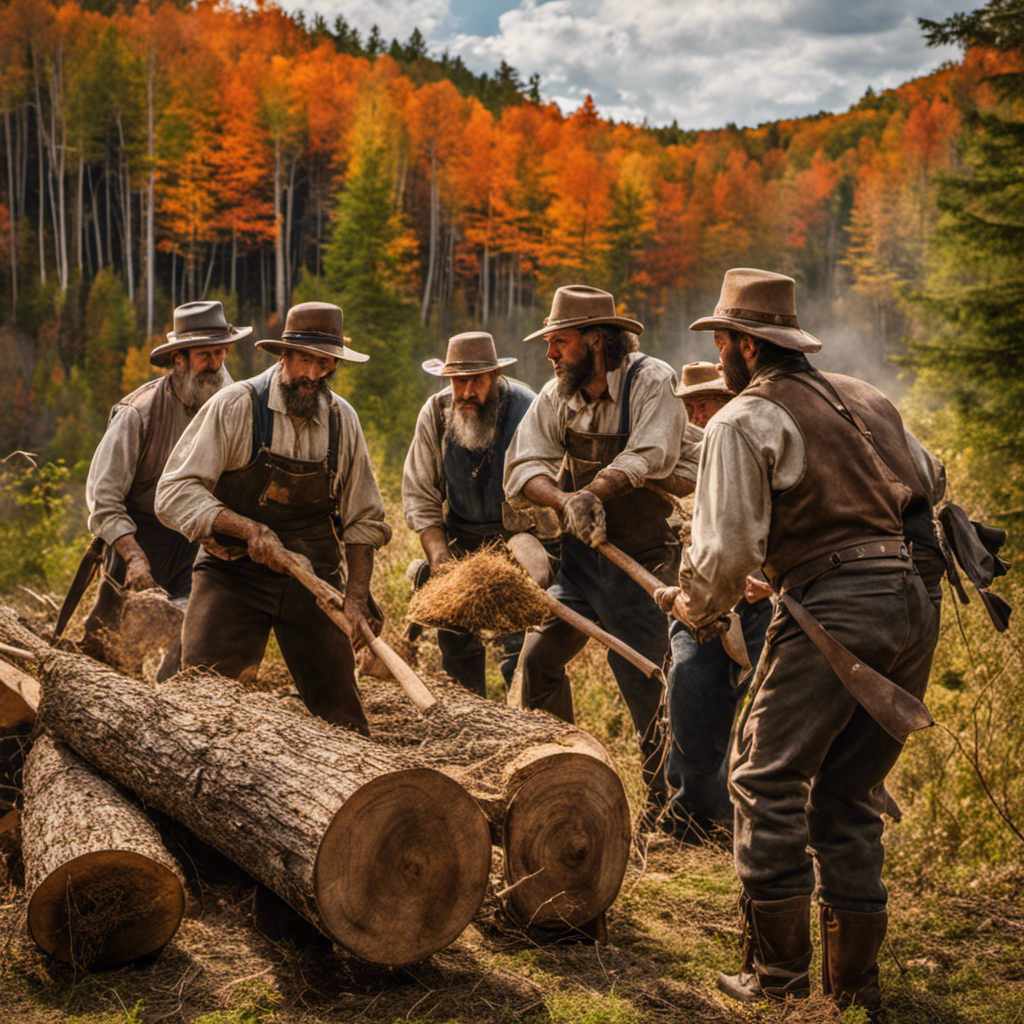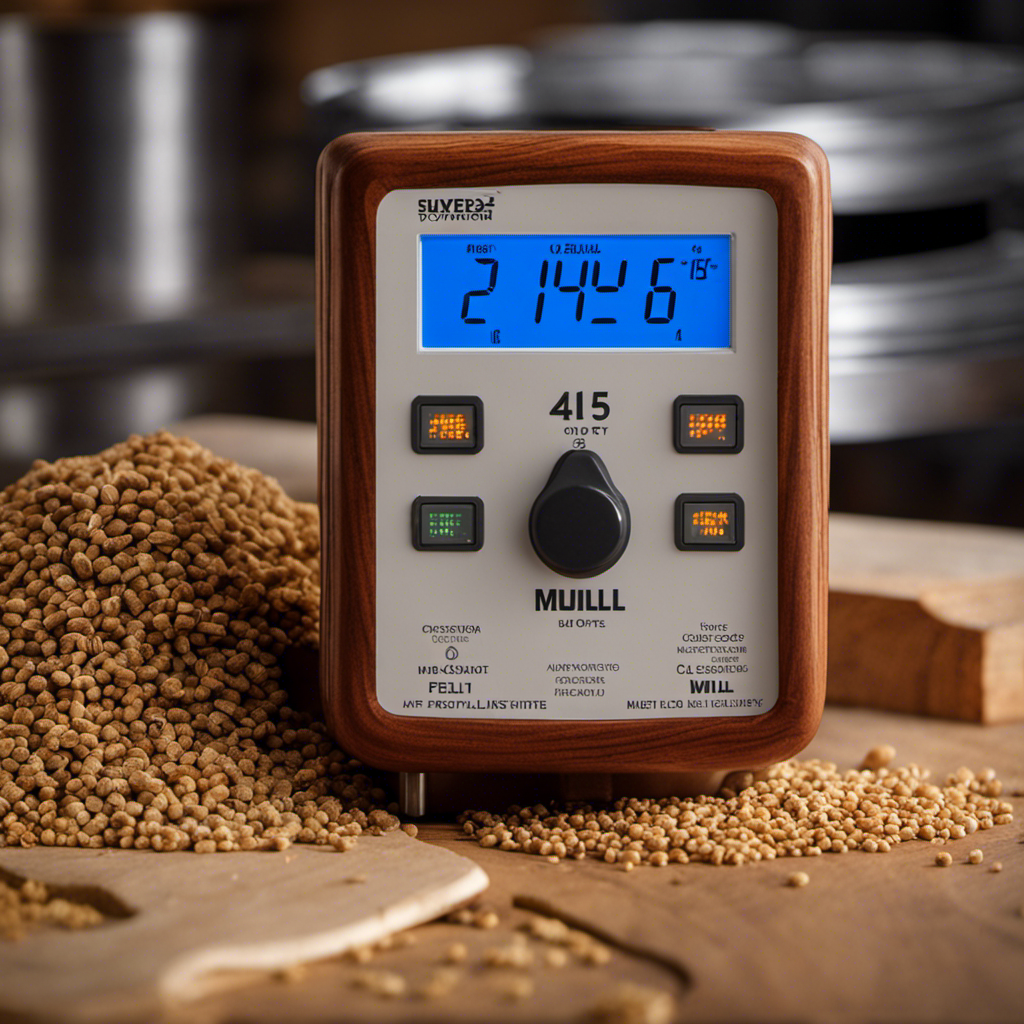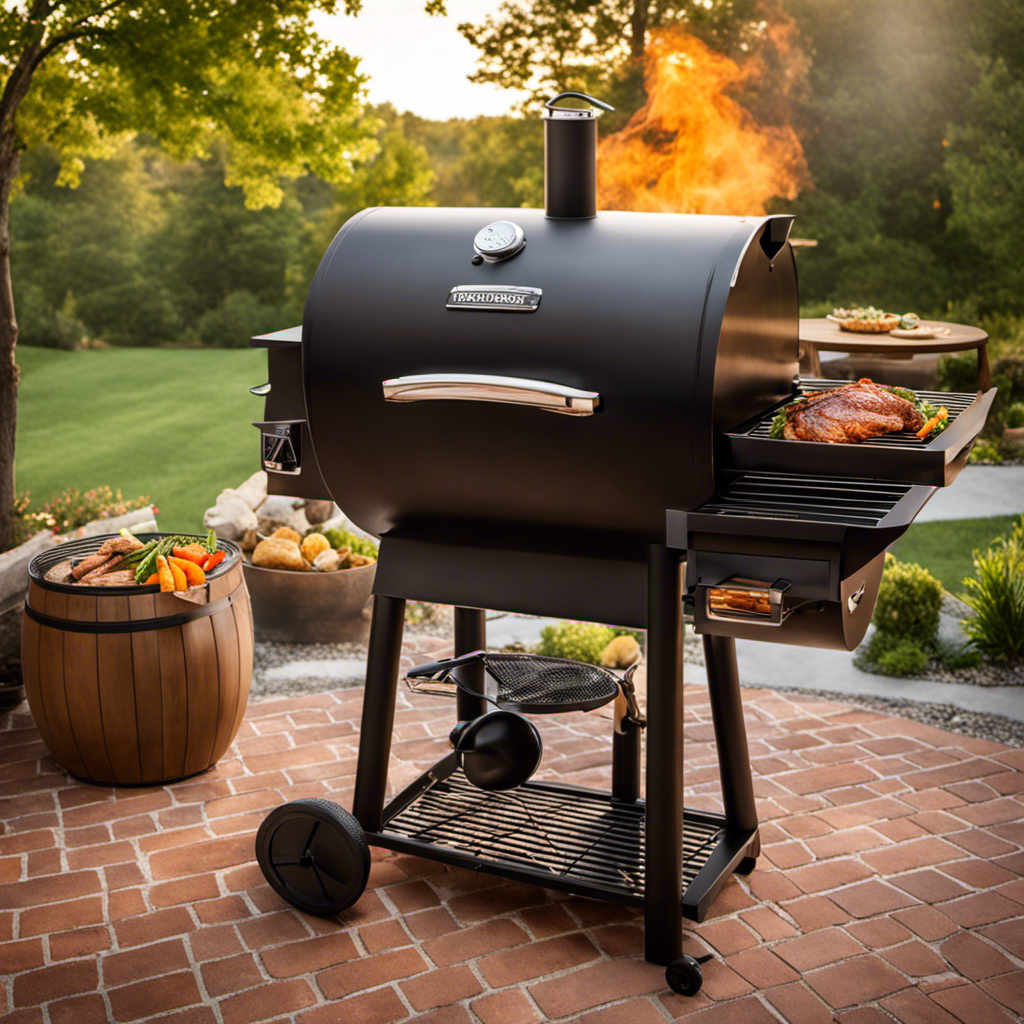As a homeowner, I constantly seek heating methods that are both energy-efficient and environmentally friendly. This is why wood pellet stoves have piqued my interest.
In this article, we’ll delve into the intricate workings of these innovative heating appliances. By understanding the basic components, combustion process, and air flow regulation in wood pellet stoves, you’ll gain valuable insights on how they function.
Plus, we’ll explore ignition procedures, cleaning guidelines, troubleshooting tips, and the energy efficiency benefits of these remarkable devices.
Get ready to discover the world of wood pellet stoves and how they can transform your home heating experience.
Key Takeaways
- Wood pellet stoves consist of a hopper, auger, and combustion chamber.
- The combustion process involves the interaction of fuel and oxygen, resulting in the release of volatile gases and the generation of heat.
- Regulation of air flow is crucial for optimal combustion and heat output, achieved through the combustion blower, exhaust blower, and pellet feed rate.
- Regular maintenance and cleaning, including checking the exhaust pipe, inspecting electrical connections, and cleaning the stove, are essential for efficiency and safety.
Basic Components of Wood Pellet Stoves
The basic components of wood pellet stoves include the hopper, the auger, and the combustion chamber. Understanding pellet combustion is crucial to appreciating how these components work together to efficiently heat your home.
Wood pellets are a renewable energy source made from compressed sawdust and other wood waste materials. They offer several benefits, such as being more environmentally friendly compared to traditional fossil fuels and having a higher energy density.
The hopper stores the pellets, which are then transported by the auger into the combustion chamber. Inside the chamber, air is forced through small holes to create a controlled burn that releases heat energy.
This transition into understanding the combustion process highlights how these components facilitate efficient and clean burning of wood pellets in your stove.
Understanding the Combustion Process
When it comes to understanding the combustion process in wood pellet stoves, two key points need to be examined.
First, the fuel and oxygen interaction is crucial for the combustion process to occur. The fuel and oxygen combine to produce heat and other byproducts. This interaction is what allows the pellets to burn and release energy.
Secondly, understanding the heat generation mechanisms helps us comprehend how energy is transferred from the burning pellets to warm up our living spaces efficiently. By understanding these mechanisms, we can optimize the efficiency of our wood pellet stoves and ensure that we are getting the most out of our fuel source.
Fuel and Oxygen Interaction
To understand how wood pellet stoves work, it’s important to consider the interaction between fuel and oxygen. The combustion process in these stoves relies on a controlled mixture of fuel and oxygen to produce heat efficiently. Wood pellets, which are made from compressed sawdust or other biomass materials, serve as the primary fuel source for these stoves. When the pellets are ignited, they release volatile gases that undergo combustion when mixed with oxygen. This combustion process generates heat energy, which is then transferred to the surrounding area through convection or radiation. To emphasize this crucial interaction between fuel and oxygen, let’s take a look at the following table:
| Fuel | Oxygen |
|---|---|
| Wood Pellets | Air |
As you can see, wood pellets require air (specifically oxygen) to burn effectively and achieve high fuel efficiency. Understanding this relationship sets the foundation for comprehending the subsequent section about heat generation mechanisms without repeating information about steps or processes involved in wood pellet stove operation.
Heat Generation Mechanisms
Understanding the fuel and oxygen interaction helps us comprehend the heat generation mechanisms in wood pellet stoves. Wood pellets, made from compressed sawdust or other biomass materials, serve as the primary fuel source. When ignited, the pellets release combustible gases which combine with oxygen from the surrounding air. This reaction occurs within a combustion chamber where temperatures can reach up to 2,000 degrees Fahrenheit. The heat produced is then transferred to the surrounding environment through various heat transfer methods such as radiation, conduction, and convection.
Efficiency improvements have been made in wood pellet stoves to maximize heat output while minimizing fuel consumption. These advancements include features like secondary combustion chambers and insulated fireboxes that enhance combustion efficiency and retain more heat within the stove. Additionally, some models incorporate advanced control systems that optimize airflow and fuel delivery for optimal performance.
Transitioning into the subsequent section about the role of pellet fuel in stove functionality, we will explore how pellet composition and quality impact combustion efficiency and overall stove operation without skipping a beat.
The Role of Pellet Fuel in Stove Functionality
You can’t underestimate the importance of pellet fuel in how your wood pellet stove operates. Pellet fuel production has come a long way, and it offers several advantages over traditional firewood. Here are four reasons why pellet fuel is crucial for the functionality of your wood pellet stove:
1) Efficiency: Pellet fuel is highly efficient due to its consistent size and moisture content. This ensures optimal combustion, resulting in less waste and more heat output.
2) Cleanliness: Unlike firewood, pellet fuel produces minimal ash and smoke emissions. This means less maintenance and cleaner indoor air quality.
3) Cost-effectiveness: Pellet fuel is often cheaper than other heating options, making it a cost-effective choice for homeowners.
4) Sustainability: Pellets are made from renewable biomass materials such as sawdust or agricultural waste, reducing reliance on non-renewable fossil fuels.
Understanding the role of pellet fuel sets the stage for comprehending how air flow is regulated in wood pellet stoves.
How Air Flow Is Regulated in Wood Pellet Stoves
For efficient operation, it’s important to regulate the air flow in your wood pellet stove. Proper regulation of air pressure ensures optimal combustion and prevents issues such as poor heat output or excessive smoke. In wood pellet stoves, air flow is regulated through various components, including a combustion blower and an exhaust blower. The combustion blower supplies fresh air to support the burning pellets, while the exhaust blower removes waste gases from the stove. By adjusting the speed of these blowers, you can control the amount of oxygen supplied to the fire and maintain consistent heat output. Additionally, regulating the pellet feed rate ensures a steady supply of fuel for continuous burning without overloading or starving the fire.
To further illustrate this point:
| Components | Function |
|---|---|
| Combustion Blower | Supplies fresh air to support burning pellets |
| Exhaust Blower | Removes waste gases from the stove |
| Pellet Feed Rate | Regulates rate at which pellets are fed into the combustion chamber |
By understanding and properly regulating these aspects of your wood pellet stove’s air flow system, you can achieve efficient and effective heating performance.
Transitioning into ‘ignition and start-up procedures,’ let’s explore how to get your wood pellet stove up and running smoothly without any hassle.
Ignition and Start-up Procedures
To ensure a smooth start-up, it’s important to follow the proper ignition procedures for your wood pellet stove. Ignition techniques can vary depending on the model and manufacturer, but here are some general tips to help you get started:
-
Clean the burn pot: Before igniting the pellets, make sure the burn pot is free from any debris or ash buildup. This will allow for better airflow and more efficient combustion.
-
Check the fuel supply: Ensure that there is an adequate supply of wood pellets in the hopper. Insufficient fuel can lead to a weak flame or even extinguish it altogether.
-
Troubleshooting tips: If you encounter any issues during ignition, such as a failure to ignite or a weak flame, check for obstructions in the venting system, clean out any clogged air intakes, and verify that all electrical connections are secure.
By following these proper ignition procedures and troubleshooting tips, you can ensure a successful start-up for your wood pellet stove.
Now let’s move on to maintaining optimal temperature levels…
Maintaining Optimal Temperature Levels
To maintain optimal temperature levels in your wood pellet stove, it’s crucial to regularly monitor and adjust the settings on the control panel. This ensures that you are maintaining temperature control and optimizing heat output. By carefully monitoring the temperature, you can make adjustments as necessary to achieve the desired level of warmth in your home. The control panel allows you to easily adjust settings such as fan speed, fuel feed rate, and ignition timing. These adjustments directly impact the amount of heat generated by your stove. To help you understand how these settings affect temperature control and heat output, refer to the table below:
| Setting | Function | Impact on Temperature Control |
|---|---|---|
| Fan Speed | Controls air circulation | Higher speed = increased heat |
| Fuel Feed Rate | Adjusts pellet delivery | Increase for more heat |
| Ignition Timing | Regulates start-up process | Faster ignition = quicker heat |
By regularly monitoring and adjusting these settings on your wood pellet stove’s control panel, you can effectively maintain optimal temperature levels while optimizing heat output.
Transitioning into the subsequent section about ‘ash removal and cleaning guidelines,’ it is important to properly maintain your wood pellet stove to ensure its longevity and efficiency without compromising safety or performance.
Ash Removal and Cleaning Guidelines
When it comes to ash removal and cleaning guidelines for wood pellet stoves, there are two key points to consider: ash disposal methods and cleaning frequency recommendations.
Properly disposing of the ashes is crucial to prevent any potential fire hazards or damage to the environment.
Understanding how often you should clean your stove will ensure optimal performance and efficiency.
Let’s delve into these topics further and explore the best practices for ash removal and cleaning in wood pellet stoves.
Ash Disposal Methods
You can easily dispose of the ash from your wood pellet stove by using a metal scoop and a designated container. Proper techniques for ash disposal methods are crucial to ensure safety and cleanliness. Here are some key points to consider:
-
Use a metal scoop: A metal scoop is ideal for scooping up the fine ash particles, as it prevents any potential fire hazards that could occur with plastic or combustible materials.
-
Choose a designated container: It is important to have a specific container solely dedicated to collecting the ash. This prevents cross-contamination and makes it easier for proper disposal.
-
Allow the ash to cool: Before disposing of the ash, make sure it has completely cooled down. Hot ashes can cause burns or ignite other flammable materials.
By following these disposal methods and techniques, you can safely remove and dispose of the ash from your wood pellet stove.
Now let’s move on to cleaning frequency recommendations for maintaining your stove’s efficiency without compromising its lifespan.
Cleaning Frequency Recommendations
Cleaning your wood pellet stove regularly is essential for maintaining its efficiency and prolonging its lifespan. Proper cleaning techniques can help remove any built-up ash or debris, allowing the stove to operate at peak performance. To clean your wood pellet stove effectively, you will need a few recommended tools.
Start by turning off the stove and allowing it to cool down completely. Then, use a wire brush or vacuum cleaner with a brush attachment to remove ash from the burn pot and heat exchanger. Pay attention to the venting system, as it can also accumulate debris over time. Finally, wipe down the exterior surfaces with a damp cloth or mild detergent solution.
By following these cleaning techniques with the recommended tools, you can ensure that your wood pellet stove remains in top condition.
However, even with proper maintenance and cleaning, wood pellet stoves may encounter certain problems that affect their performance.
Troubleshooting Common Issues With Wood Pellet Stoves
If your wood pellet stove is not producing heat, it could be due to a few common issues. Troubleshooting these problems can help you get your stove back up and running efficiently. Here are some maintenance tips and solutions for common issues with wood pellet stoves:
| Issue | Possible Cause | Solution |
|---|---|---|
| No heat | Empty hopper or clogged auger | Refill the hopper or clear any blockages in the auger |
| Poor heat | Dirty burn pot or exhaust pipe | Clean the burn pot and exhaust pipe regularly |
| Pellets not igniting | Igniter malfunctioning | Replace the igniter if necessary |
| Frequent shutdowns | Insufficient airflow | Clean air intake vents and ensure proper ventilation |
Energy Efficiency and Environmental Benefits of Wood Pellet Stoves
When it comes to wood pellet stoves, one of the most compelling reasons to consider installing one in your home is the energy savings and environmental benefits they offer. These stoves are designed to burn wood pellets, which are made from compressed sawdust and other biomass materials.
Here are some key points about the energy efficiency and environmental advantages of wood pellet stoves:
-
Energy Savings:
-
Wood pellets have a high energy density, meaning they can produce more heat per unit of fuel compared to traditional firewood.
-
Wood pellet stoves are highly efficient, with combustion efficiencies exceeding 80%.
-
The controlled burning process in these stoves minimizes wasted heat and ensures maximum energy utilization.
-
Renewable Fuel:
-
Wood pellets are considered a renewable fuel source because they are made from sustainable materials such as forestry residues and agricultural waste.
-
By using wood pellets instead of fossil fuels like oil or gas, you can significantly reduce your carbon footprint.
-
Environmental Benefits:
-
Wood pellet stoves produce lower emissions compared to traditional wood-burning appliances, resulting in improved air quality.
-
They also help divert waste materials from landfills by utilizing biomass that would otherwise go unused.
With their energy efficiency and use of renewable fuel sources, wood pellet stoves offer a greener alternative for heating your home. Now let’s delve into important safety considerations for operating these stoves without compromising their performance.
Safety Considerations for Operating Wood Pellet Stoves
To ensure the safe operation of your wood pellet stove, it’s important to regularly inspect and maintain the components. This includes the exhaust system and electrical connections. Carbon monoxide risks are a serious concern when using any combustion appliance, including wood pellet stoves. Proper ventilation is crucial to prevent carbon monoxide buildup in your home. Make sure that your stove has a clear and unobstructed path for exhausting the combustion gases outside.
Check the exhaust pipe regularly for any signs of damage or blockage, such as rust or debris. Additionally, ensure that all electrical connections are secure and free from frayed wires or loose connections.
Regularly cleaning both the inside and outside of the stove will also help maintain its efficiency and prevent potential hazards.
Frequently Asked Questions
Are Wood Pellet Stoves Suitable for All Types of Homes?
Yes, wood pellet stoves are suitable for all types of homes. They offer a convenient and efficient heating solution. Wood pellet stove installation is relatively easy and the benefits of wood pellet stoves include cost savings and reduced environmental impact.
Can Wood Pellet Stoves Be Used as the Primary Heating Source?
Yes, wood pellet stoves can be used as the primary heating source. They are highly efficient, providing warmth and cost savings. The benefits of using them include reduced carbon emissions and the ability to heat homes effectively.
How Often Do Wood Pellet Stoves Need to Be Refueled?
I find that wood pellet stoves typically need to be refueled every 24-48 hours, depending on the size and efficiency of the stove. Regular maintenance, such as cleaning the hopper and ash pan, ensures optimal performance and longevity. Using wood pellet stoves offers several benefits, including cost savings and environmental friendliness.
Are Wood Pellet Stoves Noisy When in Operation?
Wood pellet stoves can be a bit noisy during operation, but it’s not like having an elephant in your living room. The noise levels are manageable and shouldn’t have a significant impact on your home environment.
Can Wood Pellet Stoves Be Used in Areas With Strict Air Quality Regulations?
Yes, wood pellet stoves can be used in areas with strict air quality regulations. They are highly efficient and produce minimal emissions. Although the initial cost may be higher, the long-term savings make them a cost-effective heating option.
Conclusion
In conclusion, wood pellet stoves are an efficient and environmentally-friendly heating option for homes. They have basic components, such as the hopper, auger, combustion chamber, and exhaust system, which allow them to effectively burn wood pellets and produce heat. By understanding the combustion process and regulating air flow, users can ensure optimal performance. Proper ignition procedures and regular ash removal are crucial for maintaining the stove’s functionality.
One example of a case study is a family in a rural area who installed a wood pellet stove to reduce their reliance on fossil fuels and lower their carbon footprint. They were able to enjoy consistent warmth throughout the winter while also being more environmentally conscious.











